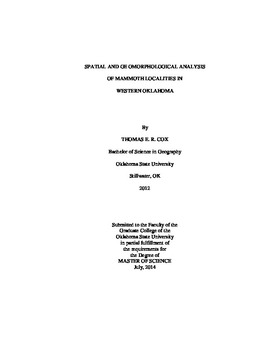| dc.contributor.advisor | Cordova, Carlos E. | |
| dc.contributor.author | Cox, Thomas Edward R. | |
| dc.date.accessioned | 2015-06-17T20:05:24Z | |
| dc.date.available | 2015-06-17T20:05:24Z | |
| dc.date.issued | 2014-07-01 | |
| dc.identifier.uri | https://hdl.handle.net/11244/14784 | |
| dc.description.abstract | Up until recently research on Paleoindian archaeology has focused on Clovis hunters and the demise of 35 genera of megafauna at the end of the Pleistocene. However, with increasing evidence of Pre-Clovis settlement many megafaunal sites older than Clovis are now under scrutiny. In this endeavor, geoarchaeology plays a key role, particularly with assessing the stratigraphic and geomorphological aspects of sites suspected of being Pre-Clovis. This Thesis looks at, and analyzes three mammoth sites in western Oklahoma; Helena, Grandfield, and Foss. These sites were analyzed on a geologic, geomorphologic, hydrologic, anthropologic, and soil pedogenic basis. Understanding of soils and their developmental processes can help give us a better understanding of the landscape and the environment in which they were formed. These sites were then compared to known sites Domebo, Hajny, and Burnham, all of which have had both an absolute date and an in depth soil analysis. The purpose of the comparison is to try and apply relative dating to a site when absolute dating is not obtainable, either due to funding, or technical issues that prevent obtaining a reliable date. It has been hypothesized that older mammoth finds should be found in higher terraces, while those of younger age, possibly with archaeological significance, should be found in lower terraces near flood plains. The three mammoth sites studied through this research are associated with lower terraces regardless of age. This example shows how complex the relationship is between site age and site distribution in the landscape. This research shows also how important is to evaluate soil development for estimating relative ages. This approach in turn is important for assessing late Pleistocene paleontological sites with potential association with Pre-Clovis human populations. | |
| dc.format | application/pdf | |
| dc.language | en_US | |
| dc.publisher | Oklahoma State University | |
| dc.rights | Copyright is held by the author who has granted the Oklahoma State University Library the non-exclusive right to share this material in its institutional repository. Contact Digital Library Services at lib-dls@okstate.edu or 405-744-9161 for the permission policy on the use, reproduction or distribution of this material. | |
| dc.title | Spatial and Geomorphological Analysis of Mammoth Localites in Western Oklahoma | |
| dc.type | text | |
| dc.contributor.committeeMember | Lightfoot, Dale R. | |
| dc.contributor.committeeMember | Donoghue, Joseph F. | |
| dc.contributor.committeeMember | Bement, Leland C. | |
| osu.filename | Cox_okstate_0664M_13494.pdf | |
| osu.accesstype | Open Access | |
| dc.description.department | Geography | |
| dc.type.genre | Thesis | |
| dc.subject.keywords | helena mammoth | |
| dc.subject.keywords | late plesitocene | |
| dc.subject.keywords | mammoth | |
| dc.subject.keywords | megafauna | |
| dc.subject.keywords | pre-clovis | |
| dc.subject.keywords | soil analysis | |
